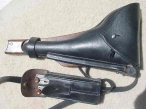
Gentlemen I will give you my opinion of this set of tools.
As many of you are aware I have been studying the manufacture of Luger holsters for some time now and have actually made many hardshell Luger holsters. Mostly Imperial 6" Navy and Baby Luger holsters.
There is little that is known about the actual German process of mass producing Luger holsters. Much has been lost to time or never recorded properly so we could observe the process in any detail.
Having replicated the hardshell myself I went through quite a learning process on how to achieve an excellent end result and some of the pitfalls along the way.
As for the brass molds, I cannot for the life of me see that these could be of any use whatsoever. When making a hardshell holster it is necessary to dry the leather very fast as leather hardens when treated this way. Also mold grows very quickly on vegatable tanned leather, in a matter of minutes or hours. Putting wet leather in these brass molds is not suitable at all to draw moisture off of leather. It would trap it inside the mold even were it to be heated. Trapped in this brass mold there is no where for it to go...Cooking leather at a high temperature would ruin it. Why use heat anyway as air drying is much cheaper, faster and does not require workers to heft around hot heavy brass molds.
I believe the Germans used a wooden mold with a skelatal framework type press on top to mold the hardshell. This would enable the wood mold to wick away water and the exposed front to evaporate. I have had great success with this method myself. A holster will dry enough to remove in a matter of a few hours. It is fast light and quickly achieves results without burning fossil fules.
The cutting dies shown bother me to some extent. They seem to want to cut out exact patterns of the holster back, inside liner etc. From my experience it is necessary to leave some overlap and excess for the body and back to adjust and correctly stitch the edges. The Germans did this with a sewing machine and it would be impossible to stitch along the edge of a Luger holster with such precision. There would also be no place for the presser foot of the sewing machine. I believe the holsters were made with some excess and trimmed to the edge.
Another point to notice is when a German holster pattern was made there are little pin point holes in many places you may not notice. They are markers for placement of the small parts such as belt loops, stock blocks or magazine pouches. The German Saddler needed to know where these were placed and these little pin holes pointed out where. These do not appear on the cutting dies that I can see. Look on any German holster at the corners of mag pouches or around any small part and you will notice them.
The wooden magazine dies shown may or may not be authentic. I cannot see them well enough to determine if they are of any use. The little bit of what appears to be German writing lends nothing to it's authenticity in my opinion.
From what little I know and have experienced this is a pile of junk. The sale got up to over $700.00. I guarentee I can show the same result for $7.00.
Jerry Burney
__________________
Jerry Burney
11491 S. Guadalupe Drive
Yuma AZ 85367-6182
l ugerholsterrepair@earthlink.net
928 342-7583 (CO & AZ) Year Round
719 207-3331 (cell)

"For those who Fight For It, Life has a flavor the protected will never know."
|